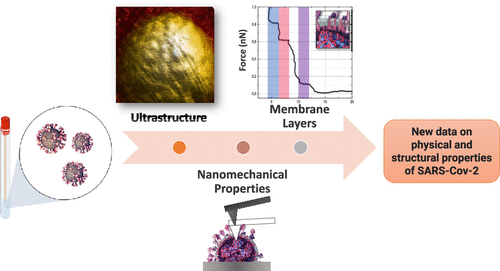Our official English website, www.x-mol.net, welcomes your feedback! (Note: you will need to create a separate account there.)
SARS-CoV-2 Unrevealed: Ultrastructural and Nanomechanical Analysis
Langmuir ( IF 3.9 ) Pub Date : 2021-08-05 , DOI: 10.1021/acs.langmuir.1c01488 Ruana Cardoso-Lima 1 , Pedro Filho Noronha Souza 2 , Maria Izabel Florindo Guedes 3 , Ralph Santos-Oliveira 4, 5 , Luciana M Rebelo Alencar 1
Langmuir ( IF 3.9 ) Pub Date : 2021-08-05 , DOI: 10.1021/acs.langmuir.1c01488 Ruana Cardoso-Lima 1 , Pedro Filho Noronha Souza 2 , Maria Izabel Florindo Guedes 3 , Ralph Santos-Oliveira 4, 5 , Luciana M Rebelo Alencar 1
Affiliation

|
The ongoing outbreak of the severe acute respiratory syndrome coronavirus-2 (SARS-CoV-2) started in late 2019 and spread across the world, infecting millions of people, with over 3.3 million deaths worldwide. To fight back the virus, it is necessary to understand how the main structures work, especially those responsible for the virus infectivity pathogenicity. Here, using the most advanced atomic force microscopy techniques, SARS-CoV-2 viral particles were analyzed, with a special focus on their ultrastructure, adsorption conformation, and nanomechanical behavior. The results uncovered the aspects of the organization and the spatial distribution of the proteins on the surface of the viral particles. It also showed the compliant behavior of the membrane and ability to recover from mechanical injuries. At least three layers composing the membrane and their thickness were measured, protecting the virus from external stress. This study provides new insight into the ultrastructure of SARS-CoV-2 particles at the nanoscale, offering new prospects that could be employed for mapping viral surfaces. The understanding of the viruses’ capacity to survive mechanical disruptions at any level and their ability to recover from such injuries can shed a light on the structure–function relationship and help us to find targets for drug action, especially for this virus that, to this day, has no course of treatment approved.
中文翻译:

SARS-CoV-2 未解之谜:超微结构和纳米力学分析
严重急性呼吸综合征冠状病毒-2 (SARS-CoV-2) 的持续爆发于 2019 年底开始,并在全球蔓延,感染了数百万人,全球有超过 330 万人死亡。为了对抗病毒,有必要了解主要结构的工作原理,特别是那些负责病毒传染性和致病性的结构。在这里,使用最先进的原子力显微镜技术对 SARS-CoV-2 病毒颗粒进行了分析,特别关注其超微结构、吸附构象和纳米力学行为。结果揭示了病毒颗粒表面蛋白质的组织和空间分布。它还显示了膜的顺应性行为和从机械损伤中恢复的能力。至少测量了组成膜的三层及其厚度,以保护病毒免受外部压力。这项研究为纳米尺度 SARS-CoV-2 颗粒的超微结构提供了新的见解,为绘制病毒表面图谱提供了新的前景。了解病毒在任何级别的机械破坏中生存的能力以及它们从此类损伤中恢复的能力可以揭示结构与功能的关系,并帮助我们找到药物作用的目标,特别是对于这种病毒,日,尚未批准任何疗程。
更新日期:2021-09-14
中文翻译:

SARS-CoV-2 未解之谜:超微结构和纳米力学分析
严重急性呼吸综合征冠状病毒-2 (SARS-CoV-2) 的持续爆发于 2019 年底开始,并在全球蔓延,感染了数百万人,全球有超过 330 万人死亡。为了对抗病毒,有必要了解主要结构的工作原理,特别是那些负责病毒传染性和致病性的结构。在这里,使用最先进的原子力显微镜技术对 SARS-CoV-2 病毒颗粒进行了分析,特别关注其超微结构、吸附构象和纳米力学行为。结果揭示了病毒颗粒表面蛋白质的组织和空间分布。它还显示了膜的顺应性行为和从机械损伤中恢复的能力。至少测量了组成膜的三层及其厚度,以保护病毒免受外部压力。这项研究为纳米尺度 SARS-CoV-2 颗粒的超微结构提供了新的见解,为绘制病毒表面图谱提供了新的前景。了解病毒在任何级别的机械破坏中生存的能力以及它们从此类损伤中恢复的能力可以揭示结构与功能的关系,并帮助我们找到药物作用的目标,特别是对于这种病毒,日,尚未批准任何疗程。



























 京公网安备 11010802027423号
京公网安备 11010802027423号